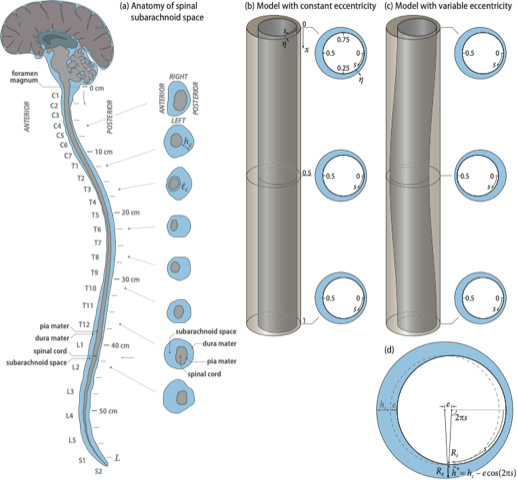"Analyses of cerebrospinal fluid flow in the spinal canal"
Séminaire Carlos Bazan
Université de Grenade
Mercredi 7 juillet à 11 h 00 Amphithéâtre Nougaro (Limité à 30 places)
ABSTRACT: The flow of the cerebrospinal fluid (CSF) in the subarachnoid space (SAS) of the spinal canal is investigated in this work. A major feature of spinal fluid flow is its oscillation, which is driven mainly by the intracranial pressure fluctuations that occur with each heart beat, resulting in an oscillatory velocity component with angular frequency ω, equal to that of the cardiac cycle. Because of the limited compliance of the subarachnoid space, the tidal volume is a small fraction ε « 1 of the total CSF volume in the spinal canal. An asymptotic analysis in the limit ε « 1 accounting for the slenderness of the flow is employed to describe the Eulerian velocity field. The oscillatory motion is seen to be determined in the first approximation by a linear unsteady lubrication problem, which can be solved to give a closed-form solution, with the nonlinear terms associated with the convective acceleration and the deformation of the canal producing a small velocity correction with a steady-streaming component. The resulting magnitude of this steady velocity is a factor ε smaller than that of the pulsating flow, yielding associated residence times of order ε-2 ω-1 » ω-1, consistent with previous experimental observations of the bulk flow in the spinal canal. In addition, the transport of a solute carried by the CSF in the spinal canal is also investigated. This work is motivated by the need for a better understanding of drug dispersion in connection with intrathecal drug delivery (ITDD), a medical procedure used for treatment of some cancers, infections, and pain, involving the direct injection of the drug into the CSF via the lumbar route. The convective transport driven by the time-averaged Lagrangian velocity (i.e. the sum of the Eulerian steady-streaming velocity and the Stokes-drift velocity) is found to be the key dispersion mechanism, while shear-enhanced dispersion is shown to be negligibly small for the typical values of the molecular diffusivity of all ITDD drugs. The analysis yields a reduced transport equation in the long-time scale, to be used in quantitative analyses of solute dispersion along the canal.






